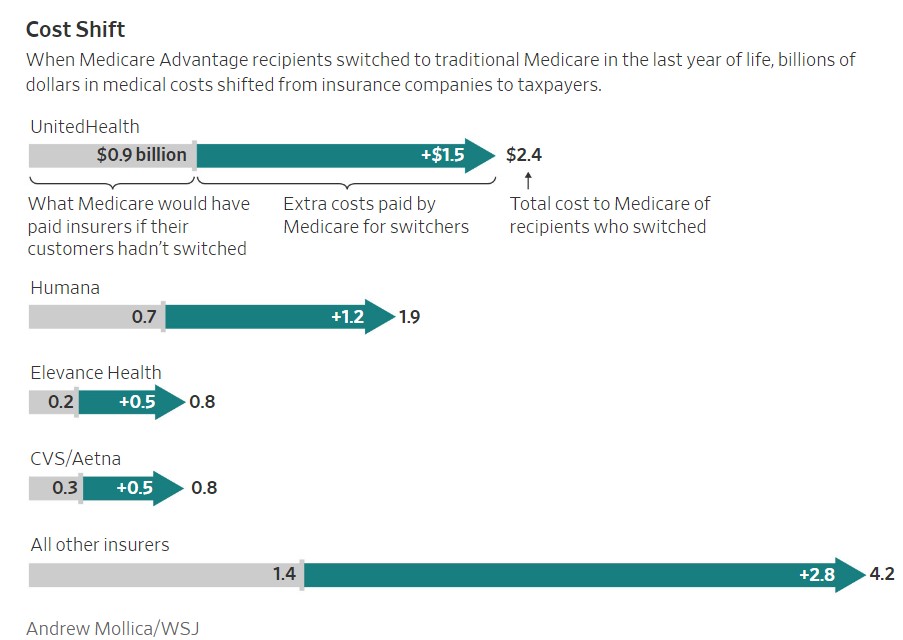Yves here. Bill Haskell at Angry Bear provided the service of summarizing an important Wall Street Journal story on the shortcomings in Medicare Advantage plans. I was remiss in not covering this article at the time and appreciate Haskell making sure the piece got additional traction.
It is not well enough understood that Medicare Advantage plans, despite the hype about extra services and even no-premium plans, are second-tier coverage. Medicare has bifurcated into Traditional Medicare, which provides generally pretty good coverage, albeit at a bit of a cost, and Medicare Advantage, which among other things has skimpier networks and a lot of gatekeeping to restrict the provision of care. The Wall Street Journal describes how adverse selection works, with patients who had enjoyed cheaper/lower service Medicare Advantage plans switching to Traditional Medicare as they get sicker.
We post regularly on the shortcomings of Medicare Advantage since some elderly prospects who can afford Traditional Medicare are too often seduced into signing up for Medicare Advantage by persistent TV ads. Mind you, there are cases where Medicare Advantage might be a good choice, mainly when contracting with an HMO affiliated with a hospital system. But even those “pretty good” plans means you are restricted to Medicare B coverage in the HMO’s footprint, and can’t, for instance, seek out specialists who are not part of that HMO’s network.
By Bill Haskell. Originally published at Angry Bear
The Government made it possible for people to choose between Traditional Medicare and Medicare Advantage for their care at 65. An alternative was provided under the guise of commercial healthcare providing better healthcare and other services to those who qualify for Medicare at a lesser cost. There are superficial and also meaningful pluses that are a part of the Medicare Advantage plans which are unavailable with Traditional Medicare. The same could be provided in Traditional Medicare except the Gov. has decided not to allow Traditional Medicare to do such. Medigap is included as a part of Medicare Advantage plan while you have to pay for it with Traditional Medicare. The same holds true for Part D (pharmaceutical).
It is said Medicare Advantage by itself can not compete with Traditional Medicare. I am finding that neither can compete with VA healthcare. That is a difference story.
As people age, the costs of healthcare increase. The cost does show up in the Medigap plans more so than in Medicare Advantage. Traditional Medicare typically sees increases in deductibles and copays for Medicare B. I am going to use part of a Wall Street Journal article and a neat graph to detail the rest of the story. I am also a subscriber to the WSJ.
As recipients get sicker, though, they may have more difficulty accessing Medicare Advantage services than people with traditional Medicare. This is the result of the insurers actively managing the care, including requiring patients to get approval for certain services, and also limiting which hospitals and doctors patients can use.
It does worsen as people age.
The Wall Street Journal found more people in the final year of their lives are leaving Medicare Advantage for traditional Medicare at double the rate of other enrollees. This was occurring from 2016 to 2022. Those private-plan dropouts numbering ~300,075 during the 2016 to 2022 time span often had long hospital and nursing-home stays after they left. The result of their going back to Traditional Medicare being large bills paid from Medicare’s Hospital Insurance (2.9% split between workers and business) fund.
In one WSJ example of end-of-life healthcare, the total cost would have been $ .9 billion if the patient was in Traditional Medicare as compared to $2.4 billion for a person who switched back to Traditional Medicare from Medicare Advantage. The Wall Street Journal provides a chart (see below) detailing the cost of switching back using various providers of MA plans as compared to Traditional Medicare.
Medicare Advantage insurers collectively avoided $10 billion in medical costs incurred by the dropouts during that period, the analysis found. If those beneficiaries had stayed in their plans, the government would have paid the insurers about $3.5 billion in premiums, meaning the companies netted more than $6 billion in savings during that period.
“These are some of the costliest services, received by some of the costliest patients,” said Claire Ankuda, a physician and researcher at Mount Sinai Hospital in New York who focuses on end-of-life care.
“Plans are strongly motivated to reduce the cost of care delivery.”
Wall Street Journal analysis of Medicare data found a pattern of Medicare Advantage’s sickest patients dropping their privately run coverage just as their health needs soared. Many made the switch after running into problems getting their care covered.
Plans run by the private insurers in the Medicare Advantage system are supposed to offer old and disabled people the same benefits they would get from traditional Medicare. The plans can be a bargain for people because they limit out-of-pocket expenses and often offer extra benefits such as dental care.
The government through CMS does pay Medicare Advantage a premium.
Medicare Advantage companies said they use Medicare’s standards when they review and approve medical services, and that their setup improves care for their members, including those at the end of life. They said their oversight ensures that customers get safe, appropriate and high-quality care.
A UnitedHealth spokesman, Matthew Wiggin, said the Journal’s analysis focused on just a tiny fraction of the company’s Medicare recipients and that nearly all Medicare Advantage participants are satisfied with the program. He disputed that care denials by insurers played a role in people’s decisions to switch out of Medicare Advantage, saying patients at the end of life might switch coverage for many reasons.
